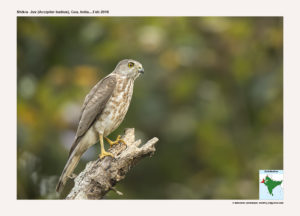Shikra

Shikra Accipiter Accipiter badius
Etymology:
- Accipiter : Latin word accipiter- hawk derived from accipere to grasp
- Badius: Latin word for “Chestnut Brown”
Vernacular Names: Hindi: Shikra (M), Chipka or Cheepak (F), Pun: Baaj, Ass: Kopauti xen, Guj: Shakro, (F) Shikro, (M) Shikri, Mar: Shikra, Ori: Baza, Ta: Vayrii, Valluru, Rajali, Te: Jail dega, Mal: Prappidian, Shikra, Sinh: Kobeyi ukussa, Kurulla goya, Nicobar: Kadeva
The name Shikra comes from the word hunter in Urdu “Shikari”. These birds were used to hunt down small prey that were further fed to falcons by falconers.
Distribution in India: Resident all over India except upper Himalayas
Description: Size of 25–44·5 cm; wt. of male 100–193 g, female 130–266 g; wingspan 48–56 cm of male and 56–68 cm of female. It is a small, relatively thickset Accipiter, with very prominent tomial tooth in small bill, proportionately short wings but long tail, and short legs and toes. It has a pale greenish-yellow cere and red (male) or deep orange or deep yellow (female) eye. The central tail feathers are unbarred and plain grey. The male is has rufous hind collar. The female is larger than male by up to 10% in size and c. 40% in mass, and is considered to be darker above, rarely has collar, and barring below is browner and less rufous. The juvenile has brown spots on breast, bars on flanks, brown eye and black line down throat. The races are separated on size and extent of brown in plumage and rufous below. The race found in India are race cenchroides (North west India), race dussumieri most of India (except N & SW) , Nominate in South West.
Habitat: It is found in dry areas with trees, deciduous woodland and savanna, from arid steppe to woodland with closed canopy; prefers broad leaf woodland and rarely found in coniferous forest; also small plantations of exotic trees, including suburban gardens. It is found from sea level to 3000 m
Food Habits: They are meat eaters. It prefers rodents, small birds and small reptiles. Their presence creates havoc amongst these small animals. Many of the small birds dive into the shrubs to avoid them. The babblers group together to look aggressive and fight them. It hunts mainly from a perch within vegetation, making a short dash to take prey on a trunk, in foliage or on ground. It rarely makes aerial pursuits, preferring to use cover to make short surprise attacks, but generally forceful in attacks on prey. It changes perch with low flap and glide flight.They would also feed on freshly winged termites and also hunt small bats at twilight.
Breeding Habits: They breed in the months of Jan-June .Both partners build the nest together. The nest is a shallow saucer shaped, made up of sticks, usually in the foliage near the top of trees. The nest is lined with green leaves and felted fur and they also use metal wires. The female lays 3-4 eggs and incubation is primarily the role of female. The male gets food for the female and the chicks for the first few weeks from hatching. The incubation period is about 20 days. The chicks are Altricial with closed eyes and some down feathers. Fledgling period is 32 days.
Their calls are mimicked by Drongos and this behaviour is thought to aid in stealing food by alarming other birds that the Drongos associate with